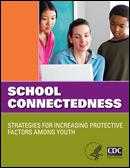School Connectedness
 School connectedness—the belief held by students that adults and peers in the school care about their learning as well as about them as individuals—is an important protective factor. Research has shown that young people who feel connected to their school are less likely to engage in many risk behaviors, including early sexual initiation, alcohol, tobacco, and other drug use, and violence and gang involvement.
School connectedness—the belief held by students that adults and peers in the school care about their learning as well as about them as individuals—is an important protective factor. Research has shown that young people who feel connected to their school are less likely to engage in many risk behaviors, including early sexual initiation, alcohol, tobacco, and other drug use, and violence and gang involvement.
Students who feel connected to their school are also more likely to have better academic achievement, including higher grades and test scores, have better school attendance, and stay in school longer.
Efforts to improve child and adolescent health have typically addressed specific health risk behaviors, such as tobacco use or violence. However, results from a growing number of studies suggest that greater health impact might be achieved by also enhancing protective factors that help children and adolescents avoid multiple behaviors that place them at risk for adverse health and educational outcomes.
Strategy Guide & Staff Development
Strategy Guide
School Connectedness: Strategies for Increasing Protective Factors Among Youth [PDF - 1M]
Six strategies that teachers, administrators, other school staff, and parents can implement to increase the extent to which students feel connected to school:
- Create decision-making processes that facilitate student, family, and community engagement, academic achievement, and staff empowerment.
- Provide education and opportunities to enable families to be actively involved in their children’s academic and school life.
- Provide students with the academic, emotional, and social skills necessary to be actively engaged in school.
- Use effective classroom management and teaching methods to foster a positive learning environment.
- Provide professional development and support for teachers and other school staff to enable them to meet the diverse cognitive, emotional, and social needs of children and adolescents.
- Create trusting and caring relationships that promote open communication among administrators, teachers, staff, students, families, and communities.
Staff Development

Staff development can strengthen school staff members' abilities to improve school connectedness for students in their school. The Fostering School Connectedness Staff Development Program is designed to
- Introduce teachers and other school staff members to the concept of school connectedness
- Generate enthusiasm and interest in improving school connectedness
- Initiate implementation of a school connectedness action plan, using ideas from School Connectedness: Strategies for Increasing Protective Factors Among Youth
This guide provides step-by-step procedures, activities, materials, resources, and PowerPoint® presentations (with speaker narrative and notes) for implementing two staff development programs — a 45-minute basic overview of school connectedness, or a 2-hour training to plan actions for improving school connectedness. Also included are interactive activities that give participants opportunities to reflect on and apply their own knowledge and experience regarding school connectedness.
Also included are interactive activities that give participants opportunities to reflect on and apply their own knowledge and experience regarding school connectedness.
Fostering School Connectedness: Staff Development Program Facilitator's Guide [PDF - 4.2M]
PowerPoint® Presentations:
- Overview of School Connectedness [PPT - 994K] | PDF [419K]
- Action Planning for School Connectedness [PPT - 1.1M] | PDF [500K]
- Page last reviewed: April 22, 2016
- Page last updated: September 1, 2015
- Content source:


 ShareCompartir
ShareCompartir
